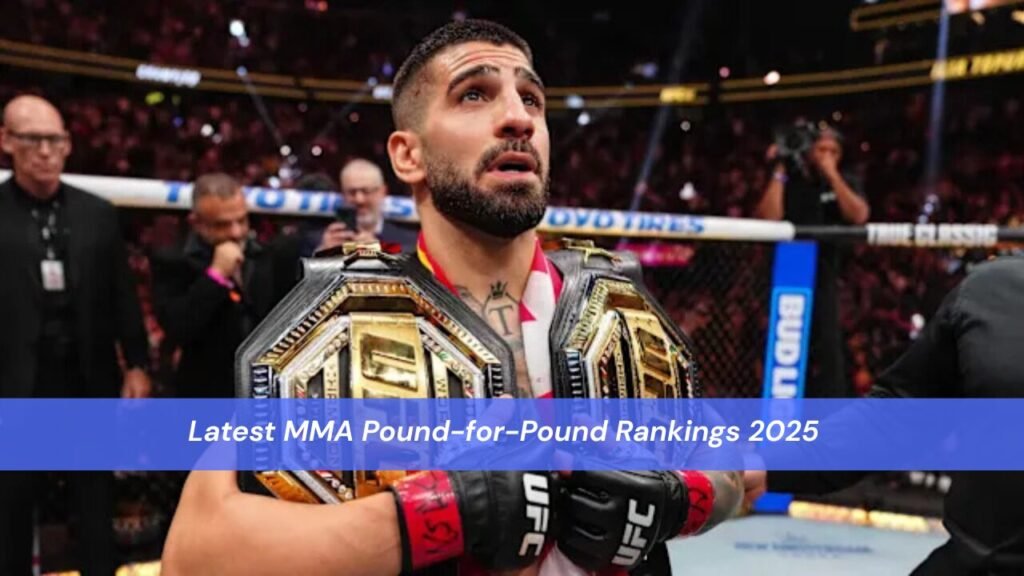The MMA pound-for-pound rankings serve as both a compass and a conversation starter in the fight world. They attempt to answer the tantalizing question: if size didn’t matter, who is the best fighter alive? These rankings matter to fans, matchmakers, promoters, and media alike, because they help frame narratives, build hype, and set expectations. In October 2025, after recent cards like UFC 320, Ilia Topuria now sits firmly at No. 1, edging past long-standing favorites like Islam Makhachev, while names such as Merab Dvalishvili and Alex Pereira continue to shake up the top 10. In this article, we’ll walk you through the current landscape, explain what drives these rankings, and offer insight into how to interpret the ongoing debates.
Why Pound-for-Pound Rankings Matter
Pound-for-pound lists are valuable because they offer a shorthand for greatness across weight classes. They let fans compare fighters in different divisions, facilitate debate, and help media outlets and promotion teams frame prestige. A fighter’s placing on a P4P list often influences how their fights are marketed and how legacy narratives are built.
However, these rankings are never purely objective. Each media outlet or panel applies its own weighting to recent performance, opponent quality, finishing ability, activity, consistency, and stylistic dominance. One fighter might be elevated for unbroken consistency, while another might be rewarded for a single spectacular knockout. As a result, the rankings shift sometimes dramatically after a single event. That’s precisely what occurred in 2025 after UFC 317 and UFC 320, when performances forced voters to rethink who truly deserves the top spots.
Because of these differences, you’ll see slight variations between ESPN’s rankings, MMA Fighting’s list, Sherdog, and the UFC’s own site. By comparing them you get a more dynamic picture of consensus and dissent.
The Updated Top 5 October 2025 Snapshot
As of early October 2025, ESPN’s men’s pound-for-pound rankings list Ilia Topuria at No. 1, followed by Islam Makhachev at No. 2 and Merab Dvalishvili holding No. 3. In the wake of UFC 320, Alex Pereira has surged into the top 5 and is now widely viewed as a serious contender for the elite. The full list includes Tom Aspinall, Khamzat Chimaev, Alexandre Pantoja, Jack Della Maddalena, and Alexander Volkanovski. ESPN.com On the UFC’s official rankings page, the same top three are featured at the top of the men’s P4P list. UFC
Ilia Topuria’s move to the top was cemented when he captured the lightweight belt at UFC 317, knocking out Charles Oliveira in emphatic fashion. That win built on a track record of finish victories, including over Max Holloway and Alexander Volkanovski, which already had fans and analysts debating whether he could supplant Makhachev. Islam Makhachev continues to maintain a strong case through his long win streak and technical dominance, even as he plans a move to welterweight. Merab Dvalishvili, known for relentless pressure and elite wrestling output, remains firmly in the top 3, after defending his bantamweight title against Cory Sandhagen at UFC 320. That victory extended his win streak and reinforced the argument that he is one of the most dominant champions in any division.
Alex Pereira’s rise is perhaps the most dramatic. In a swift rematch at UFC 320, he knocked out Magomed Ankalaev in about 80 seconds to recapture the light heavyweight belt. That performance elevated him several spots in most P4P lists, with some outlets placing him as high as No. 4. Tom Aspinall, having become undisputed heavyweight champion after Jon Jones’ retirement, continues to generate buzz in the top echelon. Sherdog now places Pereira even in the No. 4 slot, signaling that his power, finishes, and comeback momentum may carry him even further.
Importantly, these rankings reflect not just what fighters have done, but how convincingly they’ve done it, how active they remain, and whether they keep pushing their limits.
How the Rankings Shifted After Key Events What Changed and Why
The biggest jolt to the P4P landscape came from UFC 320. Alex Pereira’s emphatic knockout over Ankalaev sent shockwaves through the list. That performance didn’t just restore his light heavyweight title; it provided voters with a high-impact data point to justify moving him upward. Ankalaev, once considered among the top, tumbled in many rankings after the loss. At the same time, Merab Dvalishvili’s title defense over Sandhagen reminded many voters of his consistency and elite output; he posted 20 takedowns and extended his UFC takedown record to over 100, reinforcing his claim as one of the most durable champions.
Meanwhile, Topuria’s rise had already been building since UFC 317. His knockout of Oliveira allowed him to leapfrog many in the eyes of voters who favor finishes. But the decision to put Topuria at No. 1 only became more defensible after consistent dominant performances and the lack of a major slip from Makhachev. That said, Makhachev’s looming move to welterweight and his potential success (or failure) there will factor heavily into future ranking debates.
Another salient point is that inactivity or changing divisions can influence rankings. Fighters who fail to defend or compete often see their numbers slip, even if their past record is exceptional. That’s why staying active matters as much as reputation. Because of this, even highly decorated champions must continuously validate their top spot with performances.
Finally, narrative momentum plays a role. Pereira’s comeback, Topuria’s undefeated aura, Dvalishvili’s machine-like consistency these storylines are part of the equation. Voters often favor fighters on the rise or those making statements.
What Voters Consider The Criteria Behind Each Ranking Decision
When members of ranking panels weigh fighters, they don’t merely look at win-loss records. Instead, they evaluate multiple dimensions. Recent wins matter: a dominant finish carries more weight than a disputed decision. But legacy also influences perception, especially for those with long strings of elite competition. Voters typically assess the quality of opposition beating top-10 fighters is more meaningful than defeating unranked ones. They look at finishing rate (knockouts, submissions) and overall dominance in fights (control, volume, margin). Versatility across ranges striking, grappling, wrestling is essential, because fighters who excel only in one domain can be exposed in matchups. Activity and consistency matter hugely: being inactive for too long or failing to defend can erode a fighter’s credibility in the rankings. Finally, narrative momentum and “statement performances” can tilt opinions, especially when two fighters are closely matched on paper. In practice, comparing fighters often involves a mental checklist: who has the stronger resume in the last 12–18 months, who has defeated tougher opponents, who finishes fights more convincingly, and who shows adaptability across styles.
To compare two champions in different weights, one might examine whether they have beaten common opponents, how dominant their wins were, how active they’ve been, and how convincingly they have prevailed. Using these comparisons, you can rationalize why Topuria might edge out Makhachev in some lists while others still favor Makhachev’s consistency.
Case Study Topuria vs. Makhachev How to Judge Cross-Division Greatness
Let’s put this into a real example. Ilia Topuria and Islam Makhachev are perhaps the two fighters most often debated at the top of P4P lists in 2025. To judge them, you’d want to compare:
- Whether they share common opponents or knockout margins.
- The decisiveness of their wins (finish rate, round dominance).
- Their recent competition and activity.
- The narrative arc: is one peaking while the other shows signs of regression?
Topuria’s case is compelling: he remains undefeated, has multiple highlight-reel finishes, and now holds a championship in a second division. His knockouts of featherweight legends and his recent light heavyweight move have given him a momentum boost. Makhachev, by contrast, boasts tremendous consistency, a long win streak, powerful grappling control, and high-level decision wins. Some may argue that Makhachev’s breadth over more fights gives him a more reliable foundation, while Topuria’s burst past many opponents makes his climb more dramatic. In many ways, the debate between them is the classic contest between steady excellence and explosive ascendancy.
How Fans Should Read Pound-for-Pound Lists
Never take a single P4P list as gospel. Instead, use it as a lens. Compare multiple outlets (like ESPN, MMA Fighting, Sherdog) to see where consensus lies and where rankings diverge. Consider upcoming matchups: high-stakes fights will often reposition fighters. Watch how long each fighter has remained active and how convincingly they win if a champion rests for a year or inherits questionable wins, voters may penalize them over time. For fantasy or betting purposes, combine P4P positioning with matchup dynamics (style, form, injury). For site editors or content creators, consider building content around weekly ranking analysis or “if this fight happens” scenarios to drive engagement.
Being informed means reading past the ranking number and seeing why someone is placed where they are; the narrative behind the number often matters more than the rank itself.
Top 10 in Late 2025: Who’s Climbing and Who’s Slipping
At the moment, the top 10 includes Ilia Topuria, Islam Makhachev, Merab Dvalishvili, Tom Aspinall, Alex Pereira, Khamzat Chimaev, Alexandre Pantoja, Jack Della Maddalena, Alexander Volkanovski, and others depending on the outlet. Sherdog now slots Pereira as high as No. 4, while ESPN keeps him in the top 5 behind Aspinall.
Tom Aspinall’s story is notable: after Jon Jones’ retirement, Aspinall became full heavyweight champion and is now considered one of the most dynamic heavyweights in MMA, earning him a slot within many top-10 lists. Meanwhile, Khamzat Chimaev has been making waves with his dominant championship win at middleweight, giving momentum to climb within the rankings. Alexandre Pantoja continues to defend at flyweight, and Jack Della Maddalena, after winning the welterweight title, has broken into the P4P conversation. Volkanovski, despite his age, retains credibility thanks to resilient performances in featherweight. Movement in and out of the list occurs when fighters lose, move divisions, or become inactive so the composition of the top 10 remains fluid.
FAQs
What does “pound-for-pound” really mean in MMA?
Pound-for-pound is a conceptual tool used to compare fighters across weight classes — it imagines a world where all fighters are equal in size, and asks who is the best under those conditions. It’s not a strict metric; it’s a ranking based on evaluation, not mathematical measurement.
How often are the MMA pound-for-pound rankings updated?
Different publications update at different rates. Some update after every major UFC event (e.g., UFC 320), while others refresh weekly or monthly. The UFC’s official ranking may also adjust only when title changes or significant fights occur. For example, Pereira’s knockout at UFC 320 forced some outlets to shift their rankings immediately.
Which outlet’s rankings should fans trust?
Look for transparency. The best rankings are those that explain their criteria for example, weighting recent finishes, opponent strength, activity, and consistency. ESPN, MMA Fighting, and Sherdog typically provide explanations or rationales. Compare multiple outlets to understand where there is agreement and where subjective differences emerge.
Can a fighter drop off the P4P list if inactive?
Yes. In most systems, fighters who haven’t competed within a certain period (often 12 months) risk being removed or demoted, unless they have a confirmed upcoming fight. This ensures the list reflects fighters who remain active and relevant.
Can fighters hold multiple weight-division belts and be in the P4P list?
Absolutely. In fact, multi-division champions often gain prestige in P4P debates because they prove their skill over time across divisions. Topuria’s two-division run and Pereira’s recent reclaiming of light heavyweight illustrate that fighters can build momentum across weights, which can reinforce or boost their ranking.
Conclusion
As 2025 progresses, a few storylines are destined to shape the P4P discussion. Topuria will need to defend his newly claimed lightweight title to validate his No. 1 position. Makhachev’s move to welterweight and his result against Jack Della Maddalena at UFC 322 will be a major narrative pivot. Pereira’s next move, possibly toward heavyweight, could influence whether he becomes one of the all-time great cross-division fighters. Dvalishvili, continuing to defend and show dominance in bantamweight, will remain a stalwart in the top ranks.
To stay ahead, fans should follow multiple rankings, dig into fight metrics not just wins and losses and use the criteria in this article as a mental framework. For site editors or analysts covering MMA, consider producing “if this fight happens” P4P shifts, weekly ranking explainers, and matchup comparisons.




